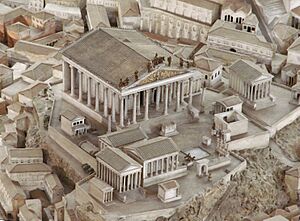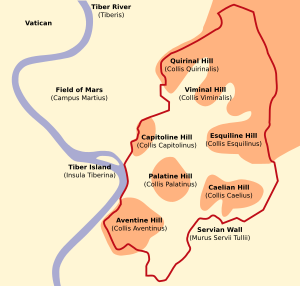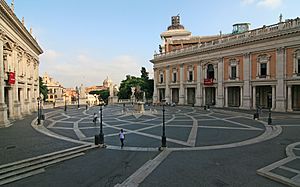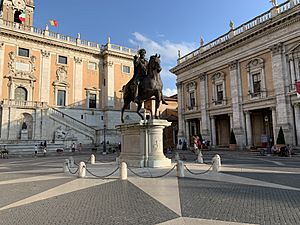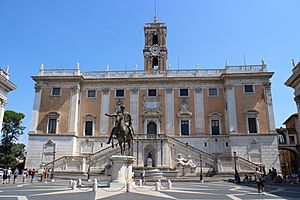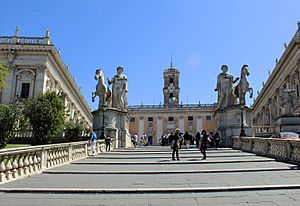Capitoline Hill facts for kids
Quick facts for kids The Capitoline Hill |
|
|---|---|
| One of the seven hills of Rome | |
| Latin name | Collis Capitolinus |
| Italian name | Campidoglio |
| Rione | Campitelli |
| Buildings | Piazza del Campidoglio, Palazzo Senatorio, Palazzo dei Conservatori, Palazzo Nuovo, Tabularium, Aedes Tensarum |
| Churches | Santa Maria in Aracoeli |
| Ancient Roman religion | Temple of Jupiter, Temple of Veiovis, Ludi Capitolini, Aedes Tensarum |
| Roman sculptures | Colossus of Constantine |
The Capitoline Hill (also called Campidoglio in Italian) is one of the Seven Hills of Rome. It sits between the famous Roman Forum and the Campus Martius. This hill has been a very important place throughout Rome's history.
Long ago, the hill was known as Mons Saturnius, named after the god Saturn. The name Capitolium first referred to the huge Temple of Jupiter Optimus Maximus built here. Later, the name was used for the entire hill. An old story says the name Capitolium comes from the Latin word caput, meaning "head." This is because when workers were digging to build the temple, they supposedly found a human head! The Romans believed the Capitoline Hill was unbreakable. It became a symbol of Rome's lasting power.
By the 1500s, the name changed in Italian to Campidoglio. Today, there are not many ancient ruins left at ground level. Most are covered by beautiful buildings from the Middle Ages and Renaissance. These buildings now house the Capitoline Museums. The word Capitolium is still used today in the English word "capitol." For example, Capitol Hill in Washington, D.C. is thought to be named after Rome's Capitoline Hill.
Contents
Ancient History of Capitoline Hill
This hill has many old stories. One famous story is about the Sabines, an ancient people. They tried to sneak into the Roman fortress on the hill. A Roman girl named Tarpeia let them in. For her betrayal, Tarpeia was thrown from a steep cliff on the hill. This cliff was later named the Tarpeian Rock after her. It became a place where criminals were often punished.
An ancient sacred area called the Vulcanal was on the lower slopes of the hill. This area was important as early as the 8th century BC. The very top of the hill was home to a temple for the Capitoline Triad. This was a group of three important Roman gods: Jupiter, Juno, and Minerva. Rome's fifth king, Tarquinius Priscus, started building this temple. The seventh and last king, Tarquinius Superbus, finished it. It was one of the biggest and most beautiful temples in Rome.
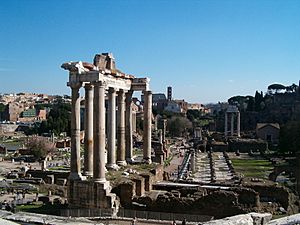
Other important temples were also built on the Capitoline Hill. These included the Temple of Juno Moneta and the Temple of Virtus. But the Temple of Jupiter Optimus Maximus Capitolinus was the most important. It was built in 509 BC and was almost as large as the Parthenon in Greece. The hill and the Temple of Jupiter became symbols of Rome, the capital of the world. The Temple of Saturn was built at the bottom of the hill, near the Roman Forum.
In 390 BC, a group of Gauls (from what is now France) attacked Rome. They captured most of the city. But the Capitoline Hill remained safe because the Roman defenders had fortified it. A legend says that Marcus Manlius Capitolinus was warned of a Gallic attack by the sacred geese of the goddess Juno.
Later, when Julius Caesar had a bad accident during his victory parade, he climbed the hill to Jupiter's temple on his knees. He did this to try and avoid bad luck. The Tabularium is a building located underground beneath the piazza. It was built in the 1st century BC to hold Roman government records. It also contains the Temple of Veiovis. For a long time, the Capitoline Hill was the heart of ancient Rome. But by the Renaissance, it had become a messy area with old buildings and was used for executions.
Medieval History
The church of Santa Maria in Aracoeli is next to the main square on the hill. It is located where an ancient Roman fortress once stood. Below the church, you can still see the remains of a Roman apartment building, with more than four floors visible.
In the Middle Ages, the hill became the center of Rome's city government. In 1144, citizens revolted against the Pope. A senator then made the Capitoline Hill his official home. This new senator's palace turned its back on the ancient forum. This change in direction on the hill was later made even stronger by Michelangelo's design. A small square was created in front of the senator's palace for public use. By the 1500s, buildings surrounded this square.
Michelangelo's Design
The current design of the Piazza del Campidoglio and the buildings around it was created by the famous Renaissance artist and architect Michelangelo Buonarroti. This was between 1536 and 1546. He was hired by Pope Paul III. The Pope wanted to create a grand symbol of the new Rome to impress Emperor Charles V, who was visiting in 1538. This was a chance for Michelangelo to design a major city square and bring back Rome's greatness.
Michelangelo's plans were very detailed. He changed the hill's old direction. Instead of facing the Roman Forum, the new civic center would face Papal Rome and the Christian church. This showed a shift towards the new, developing parts of the city. An equestrian statue of Marcus Aurelius was planned for the middle of the square. Michelangelo had to create a setting for this statue and organize the hill, which had two old buildings that were not lined up.
He planned to restore the Palazzo del Senatore with a new double staircase. He also wanted to move its bell tower to the center. The Palazzo dei Conservatori was also to be restored. A new building, the Palazzo Nuovo, would be built on the opposite side. This would create a special trapezoidal (four-sided) shape for the square. A wall and railing would be built at the front of the square, facing the city. Finally, a grand set of steps would lead up to the square from below.
Building Michelangelo's design took a long time. Not much was finished during his lifetime. But work continued carefully following his plans. The Campidoglio was finally completed in the 1600s. The special paving design was finished much later, in the 1900s.
The Piazza
Michelangelo had to solve problems with the shape of the Piazza del Campidoglio. Even with new fronts, the buildings formed a trapezoid, and they didn't face each other perfectly. Also, the whole area sloped. Michelangelo's solution was very clever.
The three redesigned buildings create a balanced trapezoidal space. You reach it by a wide, gently sloping staircase called the cordonata. This ramp was designed to slowly lift visitors towards the sky. It would bring them to the entrance of the city government buildings. The oval shape of the square, with a diamond pattern inside it, was a new take on older geometric designs. The stone paving is perfectly flat. Low steps appear and disappear around its edge, adjusting for the slope of the hill.
The center of the paving rises slightly. This makes you feel like you are standing on a giant egg, buried in the center of the city and the world. A pattern of a twelve-pointed star subtly refers to the stars. This space was called Caput mundi, meaning "head of the world." The popes never built this paving design. But Benito Mussolini ordered it completed in 1940.
Michelangelo focused on the center to fix the disorder of the Capitoline Hill. The statue in the middle gave the square a central point. The buildings defined the space around it. This space itself is a huge achievement. It feels like a giant outdoor room, enclosed but open to the sky. It can be entered through five balanced openings. Everything in the Campidoglio is designed with a strong central line and balance. The central statue and the paving pattern guide your eyes to its base.
Michelangelo also gave the old Palazzo del Senatore a central bell tower, a new front, and a grand double staircase outside. He designed a new front for the Palazzo dei Conservatori. He then planned an identical building, the Palazzo Nuovo, for the other side of the square. On the narrow side of the trapezoid, he extended the central line with a magnificent staircase. This connected the hilltop with the city below.
Marcus Aurelius Statue
In the middle of the piazza stood the original equestrian statue of Emperor Marcus Aurelius. Michelangelo designed a simple base for it. People respected this sculpture because they thought it showed Emperor Constantine, the first Christian Emperor. The bronze statue you see there today is a modern copy. The original is kept safely inside the Palazzo dei Conservatori museum nearby.
The Palazzi (Palaces)
Michelangelo designed new fronts for the three main government buildings of Rome. These are the Palazzo dei Conservatori, the Palazzo Senatorio, and the Palazzo Nuovo. He created a new front for the old Palazzo dei Conservatori. He then designed the Palazzo Nuovo to be an exact copy, like a mirror image. This brought balance to the group of existing buildings. These two buildings were built after Michelangelo's death. They were overseen by Tommaso dei Cavalieri. The only curved parts in the entire Campidoglio design are the arched tops over the windows. These give a slight curve to the otherwise straight lines of the design. All three palaces now house the Capitoline Museums.
Palazzo Caffarelli Clementino
Next to the Palazzo dei Conservatori is the Palazzo Caffarelli Clementino. This building now serves as an extra space for the museum, holding temporary exhibits. It was built between 1576 and 1583. Parts of the ancient Temple of Jupiter Optimus Maximus were removed to build this palace. For a time, it was the German Embassy in Rome. Later, the city of Rome took it over. They removed a large part of its east side to create the Caffarelli Terrace.
Palazzo dei Conservatori
The Palazzo dei Conservatori ("Palace of the Conservators") was built in the Middle Ages. It was for the local city officials, called "Conservatori of Rome." It stands on the site of a very old temple from the 6th century BC. Michelangelo's redesign of this building was special. He used very tall columns, called a "giant order," that went up two floors. These columns had smaller columns next to them.
Michelangelo's new entrance area was a fresh idea. It has flat, decorated ceilings. The columns support the ceiling at the front. Matching half-columns are against the back wall. All the windows have arched tops. A railing along the roof makes the building look long and flat. The tall columns create a feeling of a contained space. The flat lines of the roof and railings emphasize the length of the square. The front of the palace was updated by Michelangelo in the 1530s and many times after that.
In Rome, the entrance area of the Palazzo dei Conservatori was used by different trade groups. They would settle disagreements there. It was a natural place for such activities. Until the late 1400s, the main market of the city was held on and around the Campidoglio.
Palazzo Senatorio
The Palazzo Senatorio ("Senatorial Palace") was built in the 1200s and 1300s. It stands on top of the Tabularium, which once held ancient Rome's official records. Stones from the Tabularium were reused in the palace and its bell tower. Today, it is Rome's city hall.
Michelangelo designed its double staircase. This staircase replaced an older set of steps. The stairs start gently from each side and then meet in the middle. This creates a grand entrance to the palace. In front of the staircase is a fountain with statues of river gods. These represent the Tiber and the Nile rivers. There is also a statue of Dea Roma, the goddess of Rome. The upper part of the building's front was also designed by Michelangelo. Its bell tower was designed by Martino Longhi the Elder and built between 1578 and 1582.
Palazzo Nuovo
The Palazzo Nuovo ("New Palace") was built to complete the square's balanced design. It also helped to hide the tower of the Aracoeli church. Construction began in 1603, finished in 1654, and it opened to the public in 1734. Its front looks exactly like the Palazzo dei Conservatori. It's an identical copy made using Michelangelo's original plans from a century earlier.
The Balustrade
A balustrade (a row of small columns topped by a railing) with sculptures on top of the tall columns finished the design. This was one of Michelangelo's most important designs. The two large ancient statues of Castor and Pollux that decorate the balustrades today are not the ones Michelangelo originally placed there. Those are now in front of the Palazzo del Quirinale.
The Cordonata
Next to the older, much steeper stairs leading to the Aracoeli church, Michelangelo designed a grand, wide ramped staircase. This is called the cordonata. It gently goes up the hill to reach the high square. This design made the Campidoglio turn its back on the Roman Forum, which it had once overlooked. The cordonata was built wide enough for people on horseback to ride up the hill without getting off their horses. The railings are topped by statues of two black Egyptian lions at the bottom. At the top, there are marble statues of Castor and Pollux.
On the grassy slope to the northwest of the cordonata, there is a monument to Cola di Rienzo. It was put there in 1886.
Influence of Capitoline Hill
The word Capitolium still lives in the English word "capitol." This shows the influence of Roman architecture and the Roman Republic. For example, Capitol Hill in Washington, D.C. is widely believed to be named after the Capitoline Hill in Rome.
See also
 In Spanish: Colina Capitolina para niños
In Spanish: Colina Capitolina para niños
- Aventine Hill (Aventino)
- Caelian Hill (Celio)
- Capitoline Brutus
- Cispian Hill (Cispio)
- Esquiline Hill (Esquilino)
- Janiculum Hill (Gianicolo)
- Monte Mario
- Oppian Hill (Oppio)
- Palatine Hill (Palatino)
- Pincian Hill (Pincio)
- Quirinal Hill (Quirinale)
- Vatican Hill (Vaticano)
- Velian Hill (Velia)
- Viminal Hill (Viminale)


